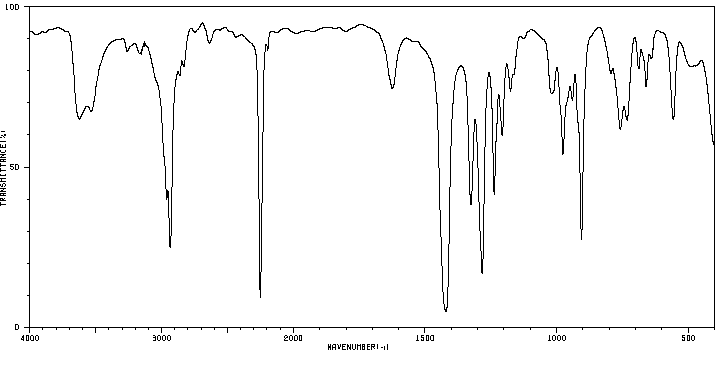1,3,5-三苄基-1,3,5-三嗪-2,4,6(1H,3H,5H)-三酮 | 606-03-1
中文名称
1,3,5-三苄基-1,3,5-三嗪-2,4,6(1H,3H,5H)-三酮
中文别名
——
英文名称
1,3,5-tribenzyl-[1,3,5]triazinane-2,4,6-trione
英文别名
N,N',N''-tribenzylisocyanurate;tribenzyl-[1,3,5]triazinetrione;Tribenzyl-[1,3,5]triazintrion;1,3,5-tribenzyl-1,3,5-triazine-2,4,6(1H,3H,5H)-trione;Tribenzyl isocyanurate;1,3,5-tribenzyl-1,3,5-triazinane-2,4,6-trione
CAS
606-03-1
化学式
C24H21N3O3
mdl
——
分子量
399.449
InChiKey
PIBKGXNSYQOGKL-UHFFFAOYSA-N
BEILSTEIN
——
EINECS
——
-
物化性质
-
计算性质
-
ADMET
-
安全信息
-
SDS
-
制备方法与用途
-
上下游信息
-
文献信息
-
表征谱图
-
同类化合物
-
相关功能分类
-
相关结构分类
计算性质
-
辛醇/水分配系数(LogP):3.9
-
重原子数:30
-
可旋转键数:6
-
环数:4.0
-
sp3杂化的碳原子比例:0.12
-
拓扑面积:60.9
-
氢给体数:0
-
氢受体数:3
SDS
反应信息
-
作为反应物:描述:1,3,5-三苄基-1,3,5-三嗪-2,4,6(1H,3H,5H)-三酮 在 palladium on activated charcoal 、 氢气 作用下, 生成 1,3,5-三羟基-1,3,5-三嗪-2,4,6(1H,3H,5H)-三酮参考文献:名称:无金属:使用 N,N',N"-三羟基异氰脲酸和乙醛肟作为催化剂在水中将伯胺新型高效有氧氧化成肟摘要:描述了一种通用的、有效的、无金属的方法,用于将芳族伯胺有氧氧化成相应的肟,由 N,N',N"-三羟基异氰脲酸和乙醛肟催化,以水为溶剂。这种实用的方法可以使用空气作为经济的绿色氧化剂,水作为绿色溶剂,并且对底物的耐受性广泛,可以以中等至良好的收率提供目标肟。DOI:10.1055/s-0033-1338646
-
作为产物:参考文献:名称:使用氧化锆环和异氰酸酯的炔烃卤代酰胺化反应及相关反应摘要:氧化锆环戊烯与异氰酸酯反应生成氮杂-或恶二唑烷环,在卤化后可方便地将其覆盖在炔烃的相应卤代酰胺化产物中。1,4-双甲基甲硅烷基取代的氧化锆环戊二烯的碘酰胺化产物收率低,而用膦稳定的锆-炔配合物则使碘酰胺化产物收率适中。另一方面,氧化锆环戊烷与异氰酸酯反应,得到异氰酸酯,异氰脲酸酯的三聚产物。DOI:10.1016/j.tet.2003.08.078
文献信息
-
Dehydrogenative Synthesis of Carbamates from Formamides and Alcohols Using a Pincer-Supported Iron Catalyst作者:Tanya M. Townsend、Wesley H. Bernskoetter、Nilay Hazari、Brandon Q. MercadoDOI:10.1021/acscatal.1c02718日期:2021.8.20already been demonstrated that the transient isocyanate generated from dehydrogenation of the formamide can be trapped with amines to form ureas and, in principle, the isocyanate could also be trapped with thiols to form thiocarbamates. Competition experiments indicate that trapping of the transient isocyanate with amines to produce ureas is faster than trapping with an alcohol to produce carbamates我们报告了钳形连接的铁络合物 ( iPr PNP)Fe(H)(CO) [ 1 , iPr PNP – = N(CH 2 CH 2 P i Pr 2 ) 2 – ] 是脱氢合成的活性催化剂来自甲酰胺和醇的 N-烷基和 N-芳基取代的氨基甲酸酯。该反应与工业相关的 N-烷基甲酰胺、N-芳基甲酰胺以及 1°、2° 和苄醇兼容。机理研究表明,反应的第一步是甲酰胺脱氢为瞬态异氰酸酯1. 然后异氰酸酯与醇反应生成氨基甲酸酯。然而,在竞争反应中,异氰酸酯与1发生可逆的环加成反应,生成非循环物质,这是催化中的静止状态。化学计量实验表明催化需要高温以促进异氰酸酯从环加成产物中释放。我们还鉴定了发生在催化几个其它非周期进程,如1,2-加成的甲酰胺或醇底物的跨中的Fe-N键1. 已经证明,甲酰胺脱氢产生的瞬时异氰酸酯可以被胺捕获以形成脲,并且原则上异氰酸酯也可以被硫醇捕获以形成硫代氨基甲酸酯。竞争实验表明,用胺
-
Cyclic tetramers of a five-membered palladacycle based on a head-to-tail-linked isocyanate dimer and their reactivity in cyclotrimerization of isocyanates作者:Seon Gye Lee、Keun-Young Choi、Yong-Joo Kim、SuJin Park、Soon W. LeeDOI:10.1039/c5dt00534e日期:——Reactions of [Pd(styrene)(PR3)2], generated from trans-[PdEt2(PR3)2] and styrene, with 2 equiv. of benzyl isocyanate in THF at room-temperature afforded unusual cyclic Pd-tetramers of five-membered rings consisting of organic isocyanate dimers and palladium, [Pd(PR3)–C(O)N(R)C(O)N(R)–}]4 (PR3 = PMe3, 1; PR3 = PMe2Ph, 2). Additionally, a cyclic trimer, (RNCO)3, 3 (R = benzyl) was produced as a catalytic的反应[钯(苯乙烯)(PR 3)2 ],从生成的反式- [PDET 2(PR 3)2 ]和苯乙烯,与2当量 室温下将异氰酸苄酯在THF中制得的五元环的非常规环状Pd-四聚体由有机异氰酸酯二聚体和钯组成,[Pd(PR 3)– C(O)N(R)C(O)N( R) - }] 4(PR 3 = PME 3,1 ; PR 3 = PME 2 PH,2)。另外,环状三聚体,(RNCO)3,3(R =苄基)作为催化产物产生。用4当量处理环状四聚体(1)。(1,2-双(二乙基膦基)乙烷)(DEPE)或(1,2-双(二甲基膦基)乙烷)(DMPE)等螯合膦容易引起金属环顺式[Pd N (R)C(O)N(R)C(O)}(P〜P)](P〜P = DEPE,4 ; P〜P = DMPE,5)以定量产率计算。相反,Pd(0)-PR 3与2当量的反应。N- CO (Ar = Ph,p - tolyl ,p -ClC
-
Reactivities of zero-valent group 10 complexes toward organic isocyanates: synthesis of metallacycles containing dimeric isocyanate units, isocyanate cyclotrimerization, and computational chemistry作者:Young-Sung Han、Kang-Yeoun Jung、Yong-Joo Kim、Kyoung Koo Baeck、Gang Min Lee、Soon W. LeeDOI:10.1039/c9nj03332g日期:——4-methoxybenzyl), depending on the alkyl substituent on R-NCO. Interestingly, these reactions afford cyclic trimers as catalytic products when two equivalents or excess amounts of benzyl isocyanate are used. In contrast, reactions of [Pt(olefin)(PR3)2] with two equivalents of an alkyl or aryl isocyanate afford only the five-membered platinacycle, namely cis-[Pt–N(R)C(O)N(R)C(O)–}(PMe3)2] (R = 3-methylbenzyl[Pd(烯烃)(PR 3)2 ](PR 3 = PMe 3,PMe 2 Ph)与两当量的芳基或异氰酸烷基酯的反应提供顺式-[Pd –N(R)C(O)N (R)C(O)–}(PR 3)2 ](R = 1-萘基,4-苯氧基苯基),它们是带有二聚异氰酸酯单元的五元帕拉达环,或作为四个五元帕拉达环的组装体的环状四聚体, [Pd C(O)N(R')C(O)N(R')}(PMe 3)] 4,(R'= 3-甲基苄基,4-甲基苄基或4-甲氧基苄基),取决于R-NCO上的烷基取代基。有趣的是,当使用两个当量或过量的异氰酸苄酯时,这些反应提供环状三聚体作为催化产物。相比之下,[Pt(烯烃)(PR 3)2 ]与两当量的烷基或芳基异氰酸酯的反应仅提供五元铂盐环,即顺式-[Pt –N(R)C(O)N( R)C(O)–}(PMe 3)2 ](R = 3-甲基苄基,4-甲基苄基,4-氟苄基,4-甲氧基苄基,(S)
-
Macrocyclic complexes containing a platinacycle or palladacycle composed of an isocyanate dimer unit: Reactivity towards isocyanides and cyclotrimerization of isocyanates作者:Jun-Hwan Choi、Kang-Yeoun Jung、Yong-Joo Kim、Hye Jin Im、Soon W. LeeDOI:10.1016/j.poly.2016.05.061日期:2016.10cyclic products as an assembly of four platinacycles or palladacycles, [M(PR3)–N(R)C(O)N(R)C(O)–}]4, were readily obtained. These cyclic tetramers were cleaved using tert-butyl isocyanide (CN–tbutyl, 4 equiv.), affording the corresponding monomeric complexes, [M(PR3)(CN–tbutyl)–N(R)C(O)N(R)C(O)–}] (M = Pt, Pd). An unusual cyclotrimerization of organic isocyanates catalyzed by zerovalent Pt complexes摘要[Pt(苯乙烯)(PMe3)2]与2当量的反应。的五元铂盐环烷基或芳基异氰酸酯,顺式-[Pt –N(R)C(O)N(R)C(O)–}(PMe3)2](R = CH2C6H5,p-ClC6H4,p -OMeC6H4)。这些络合物是含有异氰酸酯二聚体单元的铂环化合物的第一个实例。当五元双(膦)platinacycles或palladacycles用2当量处理时。容易获得由四个platinacycles或palladacycles,[M(PR3)– N(R)C(O)N(R)C(O)–}] 4组成的元素硫,16元环状产物。这些环状四聚体使用叔丁基异氰化物(CN-叔丁基,当量为4当量)裂解,得到相应的单体络合物,[M(PR3)(CN-叔丁基)– N(R)C(O)N(R) C(O)–}](M = Pt,Pd)。观察到由零价Pt络合物或五元铂环化合物催化的有机异氰酸酯的异常环三聚。此外,还研究
-
Process for the preparation of organic isocyanate compounds申请人:Kao Soap Co., Ltd.公开号:US04056547A1公开(公告)日:1977-11-01A process for preparing organic isocyanate compounds characterized by reacting a chloromethyl group-containing compound having the formula: (X).sub.n RCH.sub.2 Cl wherein X, which can be the same or different, is chlorine, alkyl, cycloalkyl, alkenyl, phenyl, chloromethylphenyl or chloromethyl, n is 0 or an integer of 1 to 3, and R is an aromatic hydrocarbon radical or an olefin radical, With an alkali cyanate, in the presence of a catalyst composition comprising (a) a cuprous salt in an amount of 0.1 to 20% by weight, based on said chloromethyl group-containing compound, and (b) a tertiary amine compound or quaternary ammonium compound in an amount equivalent to 0.05 to 1.25 gram atoms of nitrogen per gram mole of said cuprous salt, in a high-boiling-point solvent having a dieelectric constant (.epsilon.) not higher than 20, at a reaction temperature of 150.degree. to 250.degree. C, for 0.1 to 10 hours.一种制备有机异氰酸酯化合物的方法,其特征在于通过反应具有以下结构式的含氯甲基基团化合物来实现:(X).sub.n RCH.sub.2 Cl,其中X可以相同或不同,是氯、烷基、环烷基、烯烃基、苯基、氯甲基苯基或氯甲基,n为0或1至3的整数,R为芳香烃基或烯烃基,与一种碳酸氢盐反应,在催化剂组合物的存在下进行,所述催化剂组合物包括(a) 铜盐,占所述含氯甲基基团化合物重量的0.1至20%;和(b) 三级胺化合物或季铵化合物,相当于每克摩尔所述铜盐的氮原子量为0.05至1.25克摩尔,反应溶剂为具有介电常数(ε)不高于20的高沸点溶剂,在反应温度为150°C至250°C,反应时间为0.1至10小时。
表征谱图
-
氢谱1HNMR
-
质谱MS
-
碳谱13CNMR
-
红外IR
-
拉曼Raman
-
峰位数据
-
峰位匹配
-
表征信息
同类化合物
阿马诺嗪
阿特拉通
阿特拉津-乙氨基-15N1
阿特拉津-D5 同位素
阿特拉津
阿特拉嗪去异丙基-2-羟基
阿扎丙宗
达卡巴嗪相关物质B
败脂酸,丙-2-烯腈,苯乙烯
西草净亚砜
西草净
西玛津
螺拉秦
蜜勒胺
莠灭净
莠去津-特丁净混合物
莠去津-13C3
莠去津
草达津-2-羟基
草达津
苯酚,2-(4-氨基-6-乙氧基-1,3,5-三嗪-2-基)-
苯并呋喃,2-环丙基-
苯基-1,3,5-三嗪
苯嗪草酮-DESAMINO
苯嗪草酮
肼基氰尿酸盐
聚磷酸三聚氰胺
聚[[6-[(1,1,3,3-四甲基丁基)氨基]-1,3,5-三嗪-2,4-二基][(2,2,6,6-四甲基-4-哌啶基)亚氨基]-1,6-己二基[(2,2,6,6-四甲基-4-哌啶基)亚氨]]
聚(氧代-1,2-乙二氧基羰基-2,6-萘二基羰基)
羟硝基
美拉肼
美司钠EP杂质E
硫酸三聚氰胺
癸基-(二氯-[1,3,5]三嗪-2-基)-胺
甲氧丙净
甲基[2-(苯甲基氨基)-4-(4-氯苯基)-1,3-噻唑-5-基]乙酸酯
甲基6-甲基-1,2,3-三嗪-4-羧酸酯
甲基5-甲基-1,2,3-三嗪-4-羧酸酯
甲基-[1,2,4]噻嗪-3-基-胺
甲基(4Z)-4-(羟基亚胺)-2-甲基-4,5-二氢-1H-咪唑-1-羧酸酯
甲基(2E)-3-吖丙啶-1-基丙-2-烯酸酯
环氯胍硝酸盐
环氯胍
环己基三聚氰胺
环己基-(1-氧代-苯并[1,2,4]三嗪-3-基)-胺
环丙胺,N-[2-[(4-甲基苯基)硫代]乙基]-
环丙津-脱异丙基
环丙津-2-羟基
环丙津
环丙氨嗪-D4







